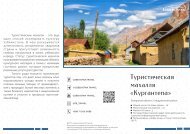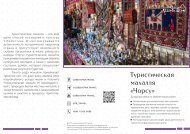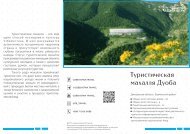Ferghana Valley English
Create successful ePaper yourself
Turn your PDF publications into a flip-book with our unique Google optimized e-Paper software.
CHUST<br />
Since time immemorial, in the very<br />
center of Chust in the Namangan region<br />
there has been a whole block of blacksmiths<br />
engaged in manufacturing knives, it is<br />
called "Suzangaron" (blacksmiths).<br />
There are many Centers for manual production of knives in Uzbekistan,<br />
however the Pichaks are always associated<br />
only with the city of Chust.<br />
In small workshops equipped with everything necessary, craftsmen create<br />
unique knives. Dozens of operations are required for the manufacture of the<br />
product; shapeless piece of metal passes many stages from virtuoso forging<br />
to hardening in the hands of experienced craftsman before it turns into a<br />
ringing steel. The artisan (Suzangar) hammers in his stamp over the almost<br />
ready blade while it is still hot after forging. According to this stamp, an<br />
experienced eye of the connoisseur will always be able to determine not only<br />
the place of production but also the name the master who made the pichak.<br />
A true Chust knife always combines external beauty with extraordinary<br />
functionality. Usually, its blade, called “tyg”, is straight, 3-4 cm wide and<br />
from 10 to 20 cm long.<br />
The source of particular pride for Chust knives is the handle, which the<br />
master creates with a special inspiration. Turned handles in elephant, saiga<br />
or deer bones inlaid with mother of pearl, silver or colored stones catch the<br />
eye, while the metal ones, richly decorated with chasing and engraving,<br />
cause lively delight.<br />
- 145 -

















